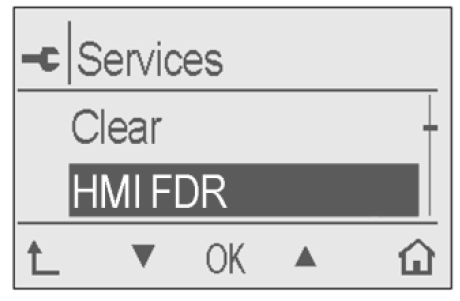Using LTMCUF (Fast Device Replacement)
Using LTMCUF is similar to using LTMCU, see .
This chapter only describes how to use specific FDR (Fast Device Replacement) services and related menus.
Backup service
In the HMI menu, when selecting the Backup service all the LTMR settings (configurations settings, LTMR and LTME commercial references, and custom logic file if used) will be downloaded to the internal non-volatile memory of LTMCUF.
The fastest way to back up the settings is to simultaneously press the two buttons with green circles for 3 seconds. The LTMCUF will start a backup sequence. This operation is equivalent to step 1 to 3 in the table below.

The other way to back up the LTMR settings is described in the table below.
Restore service
Restoration is done automatically during the LTMCUF startup sequence. It reads configuration of LTMR and compares it with the saved configuration. If the two configurations are different, LTMCUF starts to restore the configuration. LTMCUF will upload the backup memory to LTMR.
The restore operation is started if:
-
the motor is not running,
-
the LTMR and LTME commercial references match the previous configuration,
-
Backed-up memory is valid (inside LTMCUF).
The restore command can also be done manually through the Restore menu.
If custom logic is used or the Ethernet network address has changed, LTMR will reboot.
The motor needs to be stopped during the entire FDR process.
 WARNING WARNING |
|---|
|
unintended equipment operation
LTMCUF only checks that the hardware configuration matches
the saved memory. Before any operation, the user should verify that
the configuration saved into LTMCUF is suitable for the application
of the targeted LTMR. If a detected error message appears during FDR
operation, a qualified operator should check the detected error root
cause and recheck the configuration.
Failure to follow these instructions can result in death, serious injury, or equipment
damage.
|













